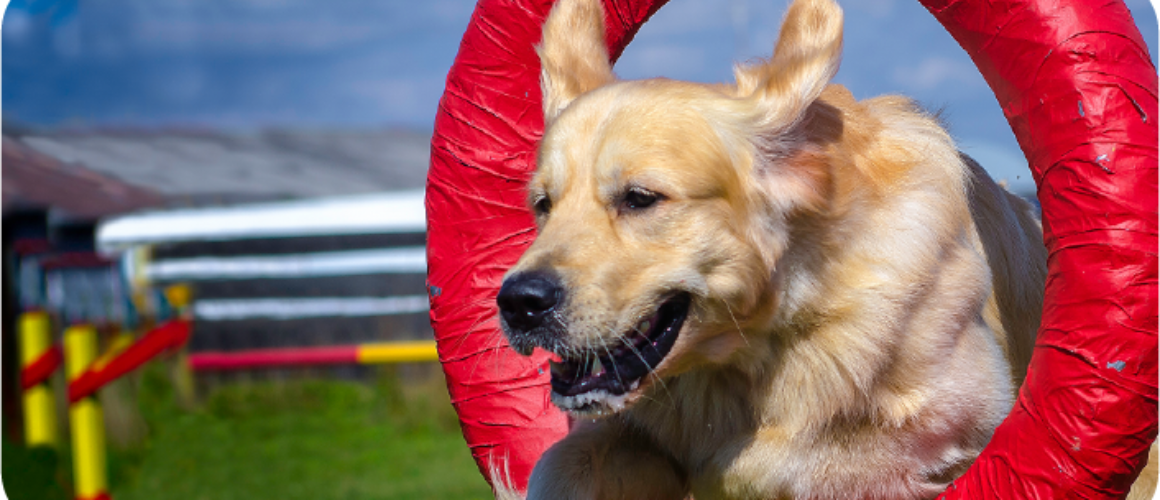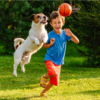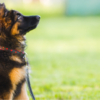Dog Training
A rewarding part of dog ownership is successfully training your dog

A rewarding part of dog ownership is successfully training your dog. Training is an excellent way to bond with your dog and will help you build a good relationship with them.
Whether young or old – all dogs can benefit from learning some basic commands. Our guides can help you with the basics of how to train your dog but we also recommend dog training classes, especially for more advanced methods such as clicker training.
A qualified behaviourist specialises in helping behavioural issues such as excessive barking, aggression, destructiveness and phobias. A dog training instructor helps owners train their pets, or teaches them to work with an animal trained to do a specific task.
If the basics such as sit, down, stay and leave are what you’re looking for – look no further…
What are the benefits of training my dog?
Teaching your dog basic obedience like sit, wait and coming back when called gives them the freedom to do the things they like to do, like running off lead and coming with you to meet friends and family, while being safe and under control.
Dogs are intelligent animals and most love to learn so training can be a great way of stopping them from getting bored.
How do dogs learn?
All training should be reward based. Giving your dog something they really like such as food, toys or praise when they show a particular behaviour means that they are more likely to do it again.
It’s important to find out what your dog really likes and what their favourite things are. Favourite treats are often small pieces of meat or cheese. The better the reward the more your dog will enjoy training and learning.
Top training tips
- Always start lessons for new tricks in a quiet room in your house away from any distractions
- Break training up into short but regular sessions so your dog isn’t overwhelmed
- Be patient, just like us, dogs all learn at different rates so don’t worry if your dog doesn’t pick things up straight away
- Always end with something your dog knows, so the session finishes positively
- Have fun!
Find a dog trainer
Why train your dog?
Training your dog is part of responsible dog ownership. It provides important mental stimulation and is a great way to get to know each other.
We recommend reward-based training to motivate and teach your dog, from an early age.
Training classes help you understand how your dog learns and provides opportunities for your dog to develop important social skills.
How to find a dog trainer
Anyone can call themselves a dog trainer, even if they don’t have the appropriate knowledge and skills. It’s important to find a good trainer as some training methods can be harmful or lead to behaviour problems.
The Animal Behaviour and Training Council sets and oversees standards of professional competence and animal welfare in the training and behaviour therapy of animals.
ABTC Registered Animal Training Instructors have been assessed as having the appropriate skills, knowledge and experience to support you and your pet. ABTC registered professionals will teach you how to train your dog ethically and in a way that meets your dog’s welfare needs.
Find an ABTC Registered Animal Training Instructor.
What to look for in a good training class
Observe a training class without your dog before joining. This gives you the opportunity to see if you feel comfortable with the instructor and methods being used.
Things to look for:
- Dog behaviour – on the first day some dogs may be anxious. Does the instructor and/or assistants help the anxious dog and their owner? In later classes the dogs should be relaxed and interested. Be wary if dogs are cowering, have their tail between their legs, or do not make eye contact.
- Training methods – look for reward-based training methods with food, play or toys. Don’t join the class if training techniques rely on fear, pain, choke chains, shouting, or hitting.
- Class size – the APDT (UK) recommends no more than 8 puppies in a class with an instructor and 1 assistant.
- Environment – Is the class calm and quiet? Lots of shouting or barking indicates high-stress levels.
- Tailored for the individual – dogs are motivated by different things and progress at different rates. Does the class allow dogs to feel relaxed before participating in activities?
- On topic – instructors should not give advice about medical issues or serious behavioural issues. Owners should be advised to speak to their vet or a clinical animal behaviourist.
Based on information from the welfare in dog training website.
How to train a dog to sit
Teaching your dog to sit is a great place to start with your training. It can be a really valuable behaviour for them to learn.
For example, teaching your dog to sit at kerbs can make crossing roads safer and asking your dog to sit when greeting people means they¿re less likely to jump up.
Teach your dog to sit in six steps:
- With your dog in a standing position, hold a tasty treat near their nose.
- Keeping the treat near your dog’s nose, move your hand in an arc over his head. As the dog raises his head to follow the treat, his bottom will go on the floor. The instant he sits, praise him and give him the treat.
- Practice this a number of times in short but regular sessions.
- As the dog always gets a treat for sitting you’ll soon find he sits for longer. You can now add the cue word ¿sit¿ as he goes to sit. Be careful not to say it before your dog moves into position or they may associate it with the wrong movement.
- Practice this a number of times in short but regular sessions.
- Give an ‘okay’ cue to let your dog know when their training has ended.
How to train a dog to stay
Teaching your dog to ‘wait’ or ‘stay’ is a simple behaviour to teach and can be really handy for keeping your dog safe, for example asking your dog to stay in the back of the car while you clip a lead on to their collar. You will need your dog to be well practiced at lying down on command before moving on to ‘stay’. This is our six step guide on how to teach a dog to stay using a positive reward system.
Teaching your dog to stay in six easy steps:
- Ask your dog to lay down.
- Give your dog a hand signal – for example a ‘stop’ sign with the palm of your hand facing your dog.
- Instead of giving your dog the treat straight away, wait a few seconds. Say ‘stay’ and then reward. It’s important to reward your dog while they are still lying down and not if they have got back up.
- Practice this many times in short but regular sessions, gradually increasing the length of time your dog stays in the down position.
- Next, you can start to increase the distance between you and your dog. Start by only taking one step back before giving them the reward and then slowly and gradually increase the distance.
- Practice in lots of different places – around the house, in the garden, at a friends and the local park.
Extra tips:
- It’s important to gradually extend the time you want your dog to stay. Practice regularly and increase the time by a few seconds each time.
- Look out for signs that your dog is going to break the ‘stay’ and reward him before he does so – set him up to win rather than fail.
- You can also teach your dog to stay in a ‘sit’ position. Follow the steps above but start by asking your dog to get into a `sit’ position.
How to train a dog to lie down
Once your dog has mastered ‘sit’ it’s time to teach them to lie down.
This is a useful behaviour when you want your dog to settle on the floor, either at home or out and about.
With your dog in a sitting position and a treat in your hand, move your hand from your dog’s nose towards their chest then straight down towards the floor. Teaching your dog to lie down in six easy steps:
- Your dog should follow the treat into a lying down position. Praise and reward them with the treat immediately.
- Practice this a number of times in short but regular sessions.
- When your dog is easily following the treat into a down position you can start to say the word ‘down’ just as your dog is getting into the down position.
- Practice this a number of times in short but regular sessions.
- While your dog is lying down give him treats – this will increase the time he spends lying down.
Extra tip:
Practice often and in different places – once your dog is happily lying down on command in your home, start to practice in more distracting environments like the garden or your local park
How to train your dog to come when called
To teach your dog to come back to you, you must learn to be more exciting than the rest of the world!
This is a really important behaviour to teach your dog because it helps to keep them safe and means they can enjoy and benefit from exercise off lead.
Teaching your dog to come to you in six easy steps:
- You need an incentive to encourage your dog to come back – a really tasty treat or a fun game with a toy. Show your dog the toy or food.
- Run away a couple of paces then call your dog¿s name and say ¿come¿ in a friendly, exciting tone – getting down low can also encourage them to come back.
- As your dog comes to you, gently hold their collar and either feed them the treat or let them play with the toy.
- Gradually increase the distance that you are from your dog, until eventually you can call your dog in and out of the garden or from room to room.
- Ask a friend or partner to help take it in turns to gently hold your dog’s collar whilst the other one walks a distance away and then calls the dog over. (Don¿t forget to praise the dog each time this is a success.)
- Once your dog is consistently coming to you when called around the house and garden you can start to practice in safe outside spaces. Long training leads can be helpful for practicing recall when outside as they allow your dog some freedom without giving them complete free-range at this stage.
Extra tips:
- Only call when you are going to praise your dog – do not call your dog and then tell them off as it means they will be less likely to come back next time you call.
- Don¿t only call your dog to put them back on the lead – they’ll soon make the association and be reluctant to come back.
- When practicing this command on walks, always take your dog’s favourite treats and toys with you so you can continue to reward him when he comes back.
How to train your dog to walk nicely on the lead
The key to teaching your dog to walk nicely on the lead is to teach them that not pulling is the fastest way to get to where they want to go.
Teaching your dog not to pull takes time, patience and consistency but the benefits can be huge.
Teach your dog to walk without pulling:
- Start by standing still and quiet. Allow your dog the full length of his lead. Remain still and quiet when your dog is ignoring you but the split second he pays you attention praise him and give him a treat.
- Once you have your dog’s attention you can move off – use your voice and treats to encourage your dog to stay close to you when walking. Always reward your dog when they are walking on a loose lead.
- If your dog moves too far away from you, before the lead goes tight, stop and be still and quiet until he pays you attention and moves closer to you. Reward and move off again. This must happen every single time your dog moves away.
- Practice this in short and regular sessions.
- Walking around distractions can cause dogs to pull. Place something your dog would really like to get to on the floor, like a toy. If your dog pulls on the lead to get towards the toy, stop and call your dog towards you. His reward for walking on a loose lead is getting to his toy. Here the dog learns that pulling just slows things down.
Extra tip:
- Make the area around you fun and rewarding so that your dog enjoys being closer to you. Lots of encouragement through praise and treats will stop him racing towards his destination.
How to train your dog to leave something alone
Some dogs can find it quite worrying and threatening when we take something away from them, especially something they value such as food or toys.
But sometimes as owners we do need to take things away, for example when they¿ve picked up something dangerous or when they are playing with your favourite scarf instead of a toy.
Teaching your dog to ‘leave’ is about teaching them that it’s OK to have something taken away because it means they¿ll be rewarded.
Teaching your dog to leave something alone:
- Offer your dog a tasty treat and encourage them to “take it” in an upbeat, friendly voice.
- Hold a treat in your hand with your fist closed around it. – Your dog will likely try to nudge and lick your hand to get the treat out – don¿t respond to any of these attempts.
- Wait patiently and don’t say anything. Wait for your dog to back-off from your hand, even just slightly/momentarily. As soon as they back-off and there is a small gap between your hand and your dog’s nose, open your hand, release the treat and give them lots of praise.
- Repeat these three steps until they consistently make the choice to move away from the treat.
- Once your dog is consistently moving away from the treat you can start to add in the cue-word ‘leave’. Say this as they back off in a gentle tone and then open your hand to give them the treat and lots of praise.
- Practice this many times in short, regular sessions.
Advanced lesson:
Once your dog has made the association between the word ‘leave’ and backing off from the treat, you can start to make it harder:
Place a treat on your open palm – meaning your dog can see and smell it. Ask your dog to leave it by saying ‘leave’.
- If your dog stays away from the treat you should reward them with lots of praise and a treat from the other hand. If your dog goes to take the treat from your open palm, simply close your hand up and wait for them to back-away.
- Give them a treat from the other hand when they successfully manage to leave the treat in your open hand.
Appropriate company for dogs
Dogs are sociable animals who enjoy company. If treated well as puppies, they learn to see us as friends and companions. If they are socialised with other dogs early it can enhance their quality of life.
Ensure your dog has appropriate company
Make sure your dog has appropriate company
- Make sure that your dog has opportunities to interact positively with appropriate companions so that they don¿t become lonely or bored. A dog may suffer if they are left without company and has nothing to do for long periods of time.
- Never leave your dog alone long enough for them to become distressed. Find out how to prevent separation related behaviours.
- If your dog is friendly towards other dogs, allow them to interact with them on a regular basis. Find out what to do when meeting an unfamiliar dog.
- Never leave your dog unsupervised with another animal or person who may deliberately or accidentally harm or frighten them.
- When you are away, make sure your dog is properly cared for by a responsible person. Why not try Rover?
- Many dogs will either chase or be afraid of animals with whom they are not familiar. If your dog is fearful of, or aggressive towards, other dogs, avoid the situations that lead to this behaviour, and seek advice from a vet or clinical animal behaviourist.
- If you have more than one dog, house them together if possible, but make sure they have enough space and can get away from one another if they want to. Introductions should be done carefully. The same applies if you have dogs and cats. For more information see our factsheets below.







